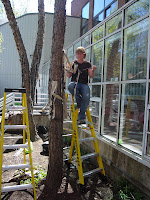 http://www.makingbooks.com/step.shtml
http://www.makingbooks.com/step.shtmlMy husband and I went to Korea last month where I was part of the Seungnam International Book Art Fair. I exhibited some of the Spirit Books and gave a coupleof workshops to children. We were welcomed with wonderful hospitality and had a chance to make friends from Korea and around the world. Our trip was only six days with two of them in airports and in the air so it took us a while to recover after our return home. I'll be posting information about the trip sometime soon. I always like to show some sample ways of using the books I make in workshops. Here's a book that I took to Korea. The first page says counting book followed by the numbers from one to nine.
I used five sheets of 4.25" x 11" colored copy paper (standard size sheets cut in half vertically). The step book works great for a counting book as the page revealed after lifting each step gets larger as you move along the book. For a variation, you can bind it using the stick and elastic technique instead of yarn.
http://www.makingbooks.com/elastic.shtml
Links
Numbers in Different Languages
A counting book can be an entry into a different culture. I'm planning on making a larger counting book with the following:
1 palace (we visited
Gyeongbokgung (Gyeongbok Palace),
2 chopsticks (Korean chopsticks are made of stainless steel),
3 azalea blossoms (I was introduced to one of Korea's most famous poems by its translator David R. McCann who is the brother of a friend from the Children's Museum),
4 handmade brushes (I bought a beautiful one in a shop in Insadong in Seoul),
5 birds (as far as I can tell the common birds we saw and loved were black-billed magpies),
6 children playing badminton (we saw lots in the park on the weekend),
7 bowls of kimchi (the fermented cabbage dish is served at every meal),
8 pairs of slippers (there were slippers in the hotel room, outside the dining room in a restaurant, and in bins at the airport where we had to take off our shoes),
9 Dunkin Donuts coffees (we were surprised to see containers of Dunkin Donuts coffee arrive at the exhibition hall especially when we have friends in the western US who miss them terribly)
Wikipedia has well organized sets of numbers from one to ten in different languages.
Korean Numbers
There are two kinds of numbers in Korean: pure Korean numbers and Sino-Korean numbers. The numbers in the Counting Book above are Sino-Korean numbers.
Sino-Korean NumbersPronunciation:
1= il
2= ee
3= sam
4= sa
5= oh
6= yook
7= chil
8= pal
9= goo
10= ship
You can hear them and then test yourself with a concentration game
here.
Korean Number SongYou may find this cute or irritating but it does go through the Korean numbers from one to ten.
Adapted from the May 2007 issue of Making Books Monthly
Free subscriptions available at
makingbooks.com









